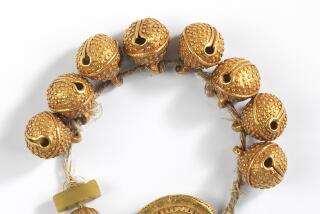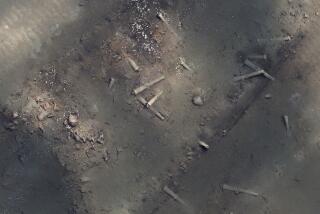The fortune hunter
- Share via
In 1981, Phil Greco gave up a traditional business career for a chance at a pot of gold.
A self-described “messed-up kid” after a tour of duty in Vietnam, Greco, now 59, managed to pull his life together and launched a string of profitable international ventures involving large liquidations of heavy equipment stocks, such as trucks, tractors and bulldozers.
But, as Greco tells it, his comfortable life changed forever when he met a friendly Dutchman sitting at the bar at the Intercontinental Hotel in Paris. Greco speaks no Dutch, and his companion spoke little English. But by the end of the conversation, the Dutchman had managed to explain to the American that he was a “treasure hunter” -- and had talked Greco into investing $150,000 in a commercial venture to recover valuables that centuries of shipwrecks had left at the bottom of the sea.
“Six weeks later, I was in Madagascar, and Mozambique,” the former New Yorker reminisced as he chain-smoked his way through a recent interview at his Sherman Oaks home. “He taught me how to dive in three days. I went down 65 feet, and I ran my hands through the sand and pulled up gold coins and gold ropes, and I was hook, line and sinker in the treasure business.”
More than 20 years later, Greco sits surrounded by the spoils of his trade, an estimated 10,000 pieces of Chinese porcelain and pottery pulled by his team of Philippine divers from shipwrecks in the sea off the Philippines. An equal number of pieces, he says, are stored in warehouses on the East Coast. The boggling array ranges from delicate powder boxes to 150-pound earthenware jars shimmering with metallic luster. Some of the objects are as much as 2,000 years old. Every shelf and table in the rented home is jammed with antiquities. As he gazes around, Greco jokes about earthquakes.
The value of the collection is still being determined. Experts in Chinese antiquities say that individual items could be worth millions -- or pennies.
And now, as he goes public with what looks to be an important new find -- seven massive Chinese statues believed to come from tombs dating to the Ming Dynasty (1368-1644), recovered from a subterranean cave -- Greco also finds himself sitting in the middle of a controversy.
Like those of other salvagers before him -- most notably the discoverers of the Titanic -- Greco’s commercial recovery effort is raising the wrath of the museum and academic communities. Critics call such private explorers “grave robbers,” accusing them not only of stealing but of disturbing important archeological sites and preventing research and conservation.
At least one Philippine official, Corazon S. Alvina, director of the National Museum of the Philippines, is up in arms over ownership, declaring that although Greco may have had permits to export some of the items in his possession, he has no permits to explore or excavate in Philippine waters. “Only the National Museum can issue permits to explore and excavate for archeological materials, both land and sea,” she says.
Greco’s attorney, David Concannon, fires back that his client received a 10-year permit to excavate from former Philippine President Joseph Estrada, who was forced out of office, and also holds other government permissions. “Phil followed the Filipino laws,” Concannon says. The lawyer concedes, however, that the excavation permit may not be recognized by the administration of current Philippine President Gloria Macapagal Arroyo. “It’s a ping-pong match,” he says.
While acknowledging the complications private salvagers can cause for the academic community, George Kuwayama, senior curator emeritus of Far Eastern art for the Los Angeles County Museum of Art, also notes that such operations have resulted in important finds. He cites the caches of valuable Chinese porcelain and gold recovered in the South China Sea in the early 1980s by Capt. Michael Hatcher, a British salvage expert. “It’s a very gray area,” Kuwayama says.
The lean, weathered Greco sports a shoe leather tan, chunks of silver jewelry and a vivid scar that divides his palm, from the time a shard of porcelain blown by typhoon winds nearly severed his hand. He is also still weak from a poisoning incident in the Philippines -- contact with rats or snake venom, he says -- that landed him in the hospital in June. He laughs a little at the ongoing dispute.
“Archeologists say, ‘What you did is not archeologically correct.’ Well, I did it,” Greco asserts. “You guys sit and have lunches in Washington with somebody else’s money, and you find one pot and you draw it for six years. Well, what about the other 5,000 pots out there?”
Greco agrees that salvage ventures raise ownership issues. “Who does own it? And who’s crazy enough to go down there and get it, and bring it 12,000 miles? It’s a different way to look at public domain,” he says.
Greco has the endorsement of undersea photographers Emory Kristoff and Ralph B. White, both formerly employed by National Geographic. White documented the expedition that located the wrecked Titanic and co-directed the 1987 salvage operation that recovered Titanic artifacts, in addition to working on James Cameron’s feature film “Titanic.”
“It becomes the archeologists against the commercial entities -- the salvagers, the treasure hunters,” says White. “The hell-for-leather boys of the old days have been replaced by the PhDs. It’s not what you’ve done, it’s how much paper you’ve produced.”
Greco has maintained a low profile during the self-financed salvage expeditions he has undertaken since his company Stallion Recoveries Ltd. was founded in 1996. But the discovery of the huge statues has inspired him to begin considering how his discoveries might best be displayed to the world.
After years of grueling work with crude equipment, he says -- he and his divers don’t carry air tanks but use weights, lines and hoses to bring air to the sea’s bottom -- he also needs to pay himself back some of the $5 million he and his wife, Jane, have invested in the business.
Greco promises to make the 14 or so Philippine workers who have played key roles in the business “millionaires in their own currency.”
Greco says that hauling the recently retrieved statues to the surface required 60 men, hoists, ladders, pulleys, blocks and tackles, and water buffaloes. The granite figures, each weighing more than a ton and standing more than 8 feet high, depict a warrior and animal guardians. He estimates the value of the warrior at $10 million and a pair of ponies at about the same amount.
Earlier this summer, Greco entered into discussions with New York-based Guernsey’s auction house for a major sale. But he has since canceled those plans because he says the auctioneers intended to sell off individual items rather than significant groupings. “I’m not going to sell it like shoes. I’m not going to do that,” he insists.
Victoria Johnson Campbell, whose Aurora Galleries International in Bell Canyon deals in fine collectibles, plans an Oct. 18 auction of about 300 of Greco’s fine art and porcelain pieces, though not the statues.
About a year ago, Campbell says, her auction house appraised a shipment of 3,600 of Greco’s pieces at $10 million. She says the grouping contains not just plentiful Ming trade porcelain, considered of little value, but rare red overglaze porcelains and valuable objects of nephrite and jade.
Greco believes the best use of the most significant pieces would be a touring show not unlike the “Titanic” exhibition that will be at the California Science Center through Sept. 1, and he hopes to sell the rights to his story. That approach, he says, would generate funds to continue his work but also preserve the integrity of the art and allow it to be enjoyed by the public.
Greco shrugs when asked if such a traveling exhibition might lure other treasure hunters to the Philippines.
“Let ‘em go. I welcome them 100%. I’ll even help them,” he says. “There are so many places you can do it. It just takes an unbelievable amount of work, and it’s very dangerous.
“I’m not a pirate, and I’m not a little boy running around with crazy ideas,” he adds. “I really and truly fell in love with the art, the beautiful glazes and colors. I got hooked on it just like I got hooked in Madagascar, with the gold in my hands.”
More to Read
Sign up for Essential California
The most important California stories and recommendations in your inbox every morning.
You may occasionally receive promotional content from the Los Angeles Times.













